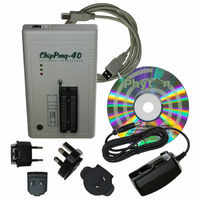CHIPPROG-40 Phyton Inc, CHIPPROG-40 Datasheet - Page 46

CHIPPROG-40
Manufacturer Part Number
CHIPPROG-40
Description
PROGRAMMER STANDALONE 40-DIP
Manufacturer
Phyton Inc
Type
Universal, Stand Aloner
Specifications of CHIPPROG-40
Contents
Programmer, Cables, CD, Power Adapter
Ic Product Type
Programmer, Universal
Ic Interface Type
USB
Features
Embedded Script Language For Automation Of Routine Operations, Splits Files To Multiple Images
Rohs Compliant
Yes
For Use With/related Products
EEPROM, EPROM, FLASH, MCU, NVRAM
Lead Free Status / RoHS Status
Lead free / RoHS Compliant
- Current page: 46 of 182
- Download datasheet (7Mb)
4.3.4.2.1 The Buffer Configuration dialog
4.3.4.2.1.1 Main Buffer Layer
46
The tab opens the dialog for configuring the main buffer layer - the 'Code' layer.
Swap Files
Use network drives
Amount of space to leave
free on each drive (GB):
Element of dialog
Buffer Name
Size of sub-layer 'Code'
Fill sub-layer 'Code' with
data:
Data to fill sub-layer with:
Shrink buffer size when
device is selected
The dialog allows the setup of sub-layers in the buffers and to make their presentation easier to work
with.
The dialog includes as many tabs as number of sub-layers exist for a particular device. Every buffer
has at least one
chosen device has other address spaces ('Data', 'User', etc.) the buffer has additional
available for setting up by clicking the appropriate tabs.
ChipProg Device Programmers
main
layer, so the tab 'Code' is always displayed on the dialog foreground. If a
Description
available for the allocation is shown here in this screen area.
If the RAM space is limited the ChipProgUSB can use some space
on the PC drives by temporary writing the buffer image to the drive.
You can select the drive or allow the program to swap the files
automatically.
Checking this box enables you to swap files on the network drives
connected to your computer.
Here you can limit the space on the drive which will be never
affected by the file swapping.
Here you can type in a name for the buffer or pick it from the history
list. By default the first opened buffer gets the name "Buffer #0".
Then you can open the "Buffer #1", etc. or give the buffer any name
you wish.
Here you can assign a size of the 'Code' layer from the drop-down
menu - from 128KB to 32MB.
The program fills the buffer sub-layers with some default information,
usually by the 'FF's or zeros. By checking these boxes you specify
when the layer 'Code' should be filled with the default information -
before loading the file or right after the device type has been chosen.
These two toggled radio buttons define if the sub-layer 'Code' will be
filled with some default information, specific for the selected device,
or by the custom bit pattern.
The buffer size usually exceeds the target device 'Code' size. By
checking this box you downsize the buffer to match the target
device and to free some computer memory.
© 2010 Phyton, Inc. Microsystems and Development Tools
sub-layers
Related parts for CHIPPROG-40
Image
Part Number
Description
Manufacturer
Datasheet
Request
R

Part Number:
Description:
Diodes (General Purpose, Power, Switching) HIREL
Manufacturer:
Infineon Technologies

Part Number:
Description:
RF Bipolar Small Signal HIREL
Manufacturer:
Infineon Technologies

Part Number:
Description:
RF Bipolar Small Signal HIREL
Manufacturer:
Infineon Technologies

Part Number:
Description:
RF Bipolar Small Signal HIREL
Manufacturer:
Infineon Technologies










